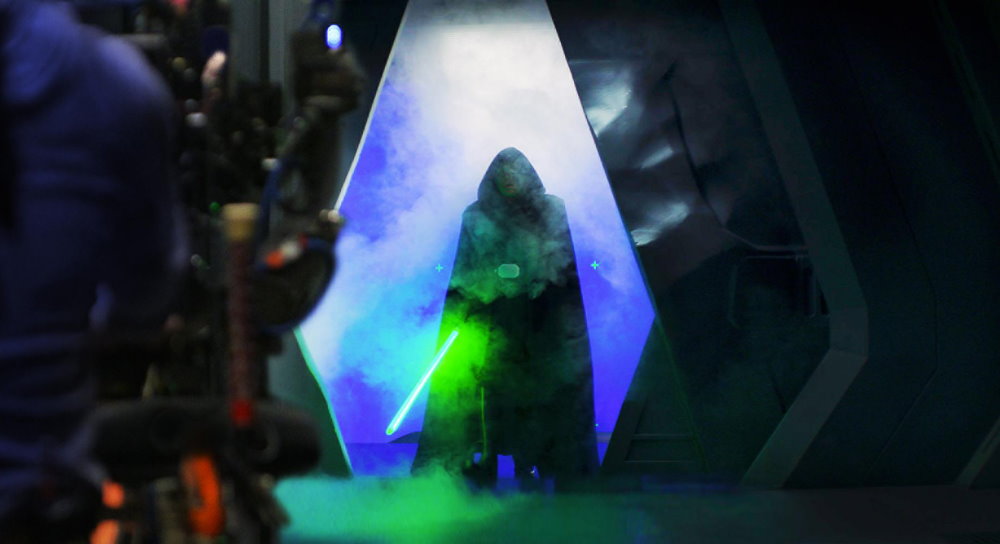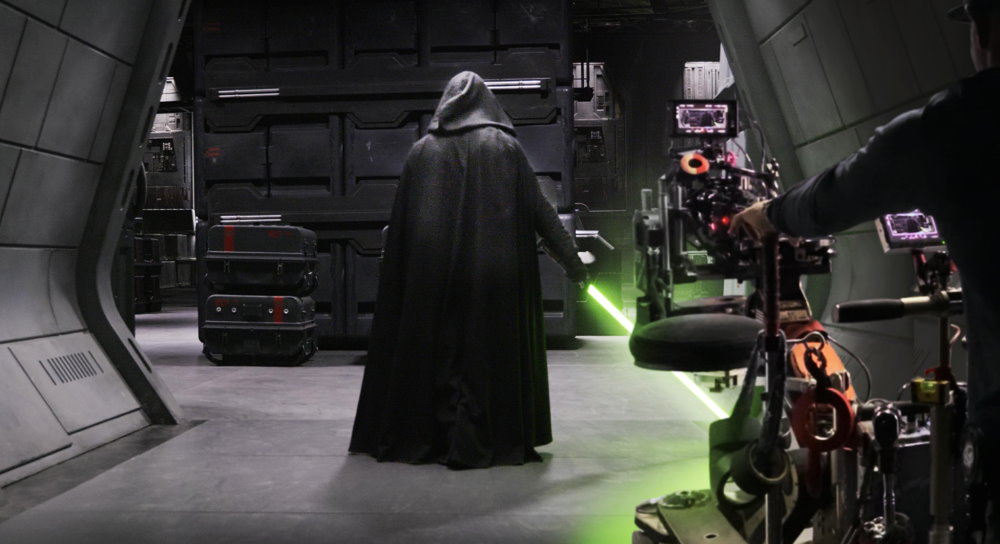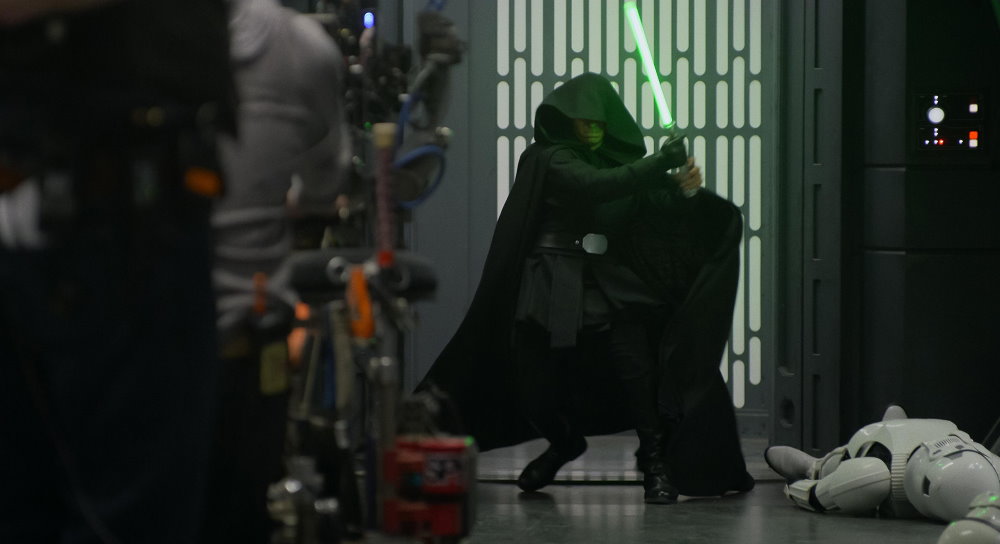“Does this look Jedi to you?”
The Tython sunlight reflects off Din Djarin’s shiny beskar as he fleetingly asks Grogu the somewhat rhetorical question. The line, as they approach the seeing stone of the ancient ruins of the Jedi Temple, from “The Tragedy” (Season 2, Chapter 14) serves as the perfect introduction to Disney Gallery: The Mandalorian: Making of Season 2 Finale.
There is no accident that Star Wars fan Jon Favreau, creator and one of the executive producers for the Disney Plus series, interplays the word “connection” to the introduction of this episode. Much like Jedi feel a strong connection to the Force, fans feel a similar heartfelt link to the stories and characters of this epic, and expanding, saga amongst the stars.
 In reintroducing Luke Skywalker, after Return of the Jedi, this behind-the-scenes of the Season 2 finale episode focuses on quite possibly the most important of all of those character relationships, especially for those of us who grew up with the Original Trilogy. Seeing the process and hearing directly from Mark Hamill almost evokes feelings of seeing Luke being trained by Yoda on Dagobah for the very first time in 1980. The emotions are raw and real and definitely not some “mumbo jumbo,” as Han Solo might phrase it.
In reintroducing Luke Skywalker, after Return of the Jedi, this behind-the-scenes of the Season 2 finale episode focuses on quite possibly the most important of all of those character relationships, especially for those of us who grew up with the Original Trilogy. Seeing the process and hearing directly from Mark Hamill almost evokes feelings of seeing Luke being trained by Yoda on Dagobah for the very first time in 1980. The emotions are raw and real and definitely not some “mumbo jumbo,” as Han Solo might phrase it.
The approach to technology and producing a younger Luke is interesting and they take the audience through the painstaking process—bringing in the usual VFX suspects of Richard Bluff and John Knoll, as well as introducing some new faces to this series in Abigail Keller, VFX producer, and Landis Fields, virtual production visualization supervisor. Entwined with this technological challenge was the subterfuge (everyone was told the Jedi would be Plo Koon, and they even had a mask for shoots) and paranoia of the big reveal being leaked as Peyton Reed, director of the episode, stressed the honor and pressure of bringing this epic moment to reality.
 Favreau praises Kathleen Kennedy as a producer and supporter but also shares a thought when reflecting upon him and Reed recruiting Hamill for the appearance that applies to his relationship with Dave Filoni and the entire production family: “We get into this ‘cause we’re fans.” Whether it’s this series, The Clone Wars, or The Bad Batch, this is why, in my opinion, some productions from Lucasfilm are more impactful than others. Favreau and Filoni are to new Star Wars stories what Baze Malbus and Chirrut Imwe are to the Guardians of the Whills. It is a more sacred calling than a job or position. And much like Baze playfully ribbing Chirrut about his devotion, we get Filoni recognizing Favreau’s “kid moment” as Luke and R2-D2 are revealed and share the screen with Grogu and company.
Favreau praises Kathleen Kennedy as a producer and supporter but also shares a thought when reflecting upon him and Reed recruiting Hamill for the appearance that applies to his relationship with Dave Filoni and the entire production family: “We get into this ‘cause we’re fans.” Whether it’s this series, The Clone Wars, or The Bad Batch, this is why, in my opinion, some productions from Lucasfilm are more impactful than others. Favreau and Filoni are to new Star Wars stories what Baze Malbus and Chirrut Imwe are to the Guardians of the Whills. It is a more sacred calling than a job or position. And much like Baze playfully ribbing Chirrut about his devotion, we get Filoni recognizing Favreau’s “kid moment” as Luke and R2-D2 are revealed and share the screen with Grogu and company.
They brought back “the guy” and his droid and it brought Favreau to tears, as he admits, Filoni talks about as a kid feeling about Artoo and Yoda as children today get to feel about Grogu. It’s easy to see how these showrunners are the historians and authentic storytellers that keep Star Wars what it is today. Reed says that the episode necessitated a “really strong, slow build.” It did and it was an appropriate finale to two amazing seasons of the show, tucked into the quilt of stories interweaving through films, shows, comic books, novels, and more that Lucasfilm and the story group continue to elevate and expand upon.
 No review can do justice to actually watching this episode, and seeing and hearing the reactions of the creators—and there are so many magical nuggets throughout that I don’t touch on here—but the most important aspect is that these artists care about the Star Wars DNA and being as true as possible to the characters and every age of fan, and this single behind-the-scenes episode helps to enforce that approach. It definitely looked Jedi to me.
No review can do justice to actually watching this episode, and seeing and hearing the reactions of the creators—and there are so many magical nuggets throughout that I don’t touch on here—but the most important aspect is that these artists care about the Star Wars DNA and being as true as possible to the characters and every age of fan, and this single behind-the-scenes episode helps to enforce that approach. It definitely looked Jedi to me.
- Trends International (Author)
- English (Publication Language)
- 28 Pages - 06/21/2021 (Publication Date) - Trends International Calendars (Publisher)


